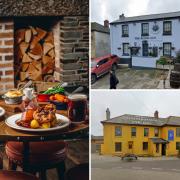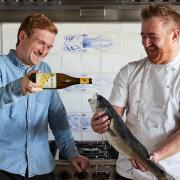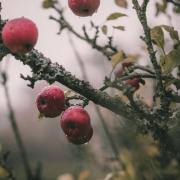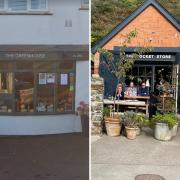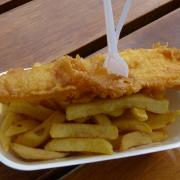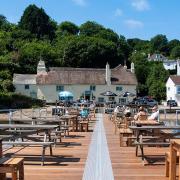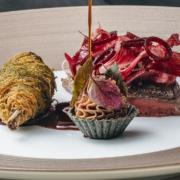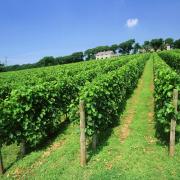Award-winning photographer David Chapman continues his tour of Cornwall's historic harbours. This month he docks in at Hayle.
Hayle harbour - or Heyl in Cornish - was once the beating heart of Cornwall. It was quite literally at the centre of the industrial revolution, from the smelting of copper to the production of ships, steam engines and mining equipment which were exported all around the world.
To learn more about the area I went for a walk around the harbour with president of the Hayle Old Cornwall Society, Trevor Smitheram, a good friend of mine who has a wealth of information on local history and knows how to tell a good story!

SNIPPETS FROM HISTORY
It was in 1756 that the Cornish Copper Company started to smelt copper in Hayle. The east end of Hayle was so dominated by this company that it became known as ‘Copperhouse’. We can still see the waste left over from the smelting process in the form of Scoria blocks, those familiar black building blocks which were used to make the Black Bridge for example. Trevor told me that this bridge and the track which leads across the top of the creek were commissioned by Reverend Hocking of Phillack Church to enable his congregation to get to church.
At the start of the 19th century copper smelting became less profitable due to competition from companies in South Wales but the Cornish Copper Company diversified into the manufacture of iron products in 1818. This brought them into competition with Harvey and Co., established in 1779, who were producing engineering equipment at the west end of the town. Between them they went on to manufacture some of the largest, and certainly the best, steam pumping engines in the world.

Trevor told me about the biggest of these steam pumps, the largest ever made in the world with a 12-foot diameter, these massive cylinders were shipped out to Holland and used to help reclaim land from below sea level. On the lake where this particular pump was employed now stands Schiphol airport and Trevor recently went to see one of the cylinders where it is now housed in the Museum De Cruquius.
It was essential for both companies to have good access through the estuary for their ships. So in the early 19th century both built large reservoirs of water and sluice gates. Using these they could hold back water from a very high tide and open the sluices to create a massive wash of water which would scour out the channels to the main estuary. We know these two tidal reservoirs as Copperhouse and Carnsew Pools, both of which are now wonderful places to see wildlife.

A local network of railway lines was already in place when in 1837 the main railway line to Redruth was opened. In 1850 the original viaduct, designed by Isambard Kingdom Brunel, constructed of timber and iron smelted by the Cornish Copper Company, was officially opened. This allowed the main railway line to continue as far as Penzance in 1852. The bridge that we see today was built in 1888.
In 1858 Harvey’s launched the iron paddle steamer, Cornubia, from Carnsew Quay. She was the fastest paddle steamer of her day and initially served as a Packet Ship sailing between Bristol and Hayle but in 1861 briefly worked the London to Lisbon route before crossing the Atlantic to play a part in the American Civil war.
Trevor told me that in total about 79 ships were built by Harvey’s in Hayle and the biggest was the SS Ramleh, launched in 1891. This was a steel cargo ship measuring 294 feet long with a gross tonnage of 3,800. It was purchased by a company in Liverpool. Soon after this time, tied in with the decline of the mining industry, ship-building at Hayle came to an end with the closure of the shipyard in 1904.

At the end of the 19th century a dynamite factory was established on Upton Towans and a rail link was made to Hayle from where the dynamite was shipped. Dynamite Quay, on the Lelant side of the estuary, wasn’t part of this process but was used by the Bickford Smith factory in Tuckingmill. Trevor pointed out that the name ‘Dynamite Quay’ wasn’t adopted until the middle of the 20th century.
The North Quay became centre of attention in the early part of the 20th century with the building, by Harvey and Co., of a coal-fired power station, which served from 1911 to 1972. In association with this the Imperial Chemical Industries established the British Ethyl Works adjacent to the power station. This factory extracted bromine from sea water using electricity generated by the power station and it utilised the hot water which was a waste-product of the power station’s cooling system. The bromine was used as part of the war effort to improve the efficiency of aviation fuel.
Hayle played a significant role in the second World War, Trevor told me that within Cornwall it was regarded as second in importance only to Falmouth. Gun emplacements and pill boxes were established around the mouth of the estuary and high over the surrounding landscape. Clearly the power station, fuel depot, bromine and gas works could all have been important targets for German bombers but the harbour area was also being used by the Americans to build and subsequently launch rhino barges from landing slopes on The Spit, near Carnsew Pool. These rhino barges were massive floating platforms capable of carrying up to 500 tons of tanks and artillery. They were incredibly important to the success of the D-Day landings.

PRESENT DAY
Over the last few decades Hayle harbour has seen much less commercial use. With factories and power station closed it has become more of a tourist destination than a centre of manufacturing and industry.
Plans to redevelop the harbour have been mooted for decades but none have got past the starting blocks until now. Recently developments have begun. First on South Quay we had a supermarket, subsequently on North Quay we have a major development of houses and flats with more to come. It seems likely that South Quay will be further developed in the not too distant future and Hayle will soon look a very different place.
PHOTOGRAPHY
Unlike many Cornish harbours Hayle has a very open aspect which means it can be photographed early and late in the day when the low sun casts its warm tones over the area. It is definitely best at high tide and I think early morning offers the greatest chance of calm water and good reflections.
I am grateful to Nathan Harvey for providing the aerial views of the harbour using his drone. These provide a wonderful opportunity to see the layout of the harbour from above.
WILDLIFE

The tidal parts of the Hayle Estuary, including Copperhouse and Carnsew Pools are owned by the RSPB. They form one of the most significant nature reserves in the county with a huge number of birds present particularly through the autumn and winter. This is the most westerly estuary in England and is the last, or first, staging post for many migrating wetland birds. It also offers a refuge for wintering birds which migrate north to breed in the Arctic during summer.
Through winter expect large numbers of wigeon, teal, curlew, oystercatcher, lapwing, golden plover and gulls. On Carnsew Pool look for little grebes and great northern divers. Among the little egrets there might be the odd spoonbill or great white egret. There are always kingfishers flying around the harbour landing on boats and moorings.
The best access points for bird watching are at Ryan’s Field, where there is a car park and hide (found by taking the turning for St Erth from The Causeway); and at Copperhouse Creek where visitors can park in the swimming pool car park. It is usually best to visit on a rising tide. The hide at Ryan’s Field is always best on a very high tide,
Hayle Old Cornwall Society welcomes new members. If you are interested in joining contact Trevor on 01736 756793.
To see more of David’s photography visit his website at davidchapman.org.uk or look out for his book ‘Photographing Cornwall’ available in all local bookshops.








